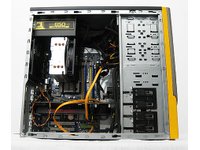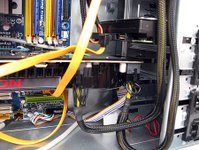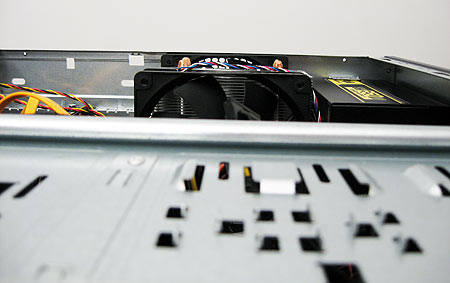System Builder Marathon: $1,250 Mid-Range PC
Assembly And Overclocking
This time around, with an established Core 2 Quad CPU and P45-based motherboard, we have very little to report about the hardware assembly and operating system installation.


All of the components fit inside the Rosewill Wind Ryder case without complaint, including the long Radeon HD 4870 X2.
Our only concern was that the massive Xigmatek HDT-S1283 cooler would pose a problem and prevent the case cover from fitting, but although it appeared to be close, it never touched a thing.
As we mentioned, the case surprised us with its good finish, build quality, and quiet fans, which are somewhat uncommon traits to discover in such a low-priced case.
Once everything was put together, the Gigabyte GA-EP45-DS3L motherboard booted up without a hitch, using proper multipliers and frequencies without a BIOS upgrade. We didn't need to make a single tweak. The 32-bit Vista Ultimate operating system also installed without incident.
We happily continued by benchmarking the system without crashes or any other incidents of note. We then turned our attention to overclocking the happy little system.
Overclocking
Get Tom's Hardware's best news and in-depth reviews, straight to your inbox.
As with our experience assembling the system, it wasn't much trouble at all to overclock this month's enthusiast system. Unfortunately, without a more expensive liquid-cooling setup, temperatures were once again our limiting factor.
We're not complaining about the job our Xigmatek HDT-S1283 did because it performed well for an air cooler in the situation in which it was placed, but there's no denying that a Q9550 can produce a lot of heat when pushed.
We tweaked some voltages and settings and were able to boot to a front side bus (FSB) speed of 400 MHz on the first try and a 3.4 GHz CPU speed. Encouraged, we tried to up the bus speed but encountered crashing.
We set the Vcore to 1.35 V and to 1.3 V for the CPU termination, MCH core, and ICH core. Memory was upped slightly to 1.9 V, and we limited the PCI Express (PCIe) bus to 100 MHz. We turned off virtualization and thermal throttling as well. With these settings we were able to set the FSB to 425 MHz, for a 3.61 GHz clock speed.
Without pushing further, we wanted to see how hot and stable the system was at this speed, so we performed some Prime95 testing. While the system was completely stable, the Speedfan monitoring application reported temperatures of 77 degrees Celsius at load. Since we accepted high temperatures in our Core i7 920 testing from our last SBM (and considering that the CPU would probably never be stressed that hard except in a synthetic benchmark like Prime95), we continued with the ~800 MHz overclock and called it a day. A clock speed of 3.62 GHz is an acceptable overclock for a Q9550 on air and we wanted to produce some results that a buyer might reasonably expect from similar components.
Sapphire's 4870 X2 card was the next overclocking focus. In our experience, dual-GPU cards like the 4870 X2 can be a little fussy when overclocking, but we were happy to see that the card would allow us to max out the Catalyst driver's Overdrive option without displaying any artifacts. Unfortunately, the driver maxed out at an overclock of 780 MHz on the core and 950 MHz on the memory, which was a mere 30 MHz core overclock and a 50 MHz memory overclock. While this won't break any overclocking records, it turned out to be almost identical to the overclock we got in our e8500/4870 X2 SBM build, which overclocked at 777 MHz core and 950 MHz memory.
Locked and loaded, we went forth into benchmarking territory...
Current page: Assembly And Overclocking
Prev Page Power Supply, Optical Drive, And Video Card Next Page Test System And BenchmarksDon Woligroski was a former senior hardware editor for Tom's Hardware. He has covered a wide range of PC hardware topics, including CPUs, GPUs, system building, and emerging technologies.
-
johnyeah I just checked, I was wondering if the HD 4850 x2 (2x1gb) was a better choice at only $240? That would cut the cost by an additional.Reply -
xx12amanxx Phenom 2 940 is 40$ dollars cheaper overclock's to 3.7-3.9 on air runs cooler and performs the same. Not sure why you went with an equal performing lower overclocking higher power using and almost 40$ more expensive cpu.Reply -
Tindytim You're $96 under budget, but you couldn't splurge on a better case?Reply
Unless you made a Typo on one of those prices, they all add up to the 1154 total. So why are you so under budget? -
Crashman xx12amanxxPhenom 2 940 is 40$ dollars cheaper overclock's to 3.7-3.9 on air runs cooler and performs the same. Not sure why you went with an equal performing lower overclocking higher power using and almost 40$ more expensive cpu.Reply
Can't use a processor that doesn't exist. They weren't on the market when the parts were ordered...what, you thought these articles were produced overnight?
TindytimYou're $96 under budget, but you couldn't splurge on a better case?Unless you made a Typo on one of those prices, they all add up to the 1154 total. So why are you so under budget?
Prices dropped after the parts were ordered: The same thing happens to EVERY builder, the system loses value almost as soon as you can click the "buy" icon. -
Tindytim CrashmanPrices dropped after the parts were ordered: The same thing happens to EVERY builder, the system loses value almost as soon as you can click the "buy" icon.Wait, wait, wait.Reply
You mention that in the $625 article, but those were the prices at purchase. Why the inconsistency? -
Crashman TindytimWait, wait, wait.You mention that in the $625 article, but those were the prices at purchase. Why the inconsistency?Reply
Ask the author of the other article? I only know that the more expensive a part is, the more money you loose when the price drops. -
maxwellsmart_80 *SIGH* Yet ANOHTER "Intel System Build Marathon" machine...just kidding - I understand what you are saying about the Phenom II 940 not being available at the time of component purchase - It would be nice to see some AMD in next months articles though!Reply
P.S. - you were under budget, why not go w/ the Antec Three Hundred Case - it's 1000% nicer than the Rosewill Piece 'o Junk you picked, and would have cooled your Overclock a lot better IMHO...just a thought - it's a killer case for the money - have you ever used it in a system build? -
yellowfever This is my first time commenting on any article at Tom's after reading everyday for 6+ years, but seeing the UD3LR motherboard pick instead of the equally priced UD3R ($2 more after rebate) or UD3P($12 more after rebate) is ridiculous for a computer hardware website. Both boards would let you do 24/7 clocks of 4+ at decent voltages on air for an E0 stepping Q9550. Gigabyte isn't going to iron out bios wrinkles on their cheapest UD3, don't forget even the UD3R was easilly beaten in stability against the UD3P until two to three months ago when better bioses started popping up. Maybe it's late, but some strange hardware gets picked on this site to save $12.Reply -
SlyNine I would have thought your OC would have been more limited by the 4pin CPU Power on the motherboardReply -
_horse Im diggin' the build here, regardless of newer hardware being available later, and prices dropping after purchase.Reply
Suggestion: Why not split these articles up into two forms? Why not submit an "initial/at time of order" article and have that listed first to let people argue, then do all the benchmarking and submit a followup article later, attached to the initial article?
People can still bicker over price range and stuff before the benchmarks even come out, that way you know what/when the article is being based off of.
I know, Im the new guy and Im probably spitting in to the wind here, but...
:)
-Horse

